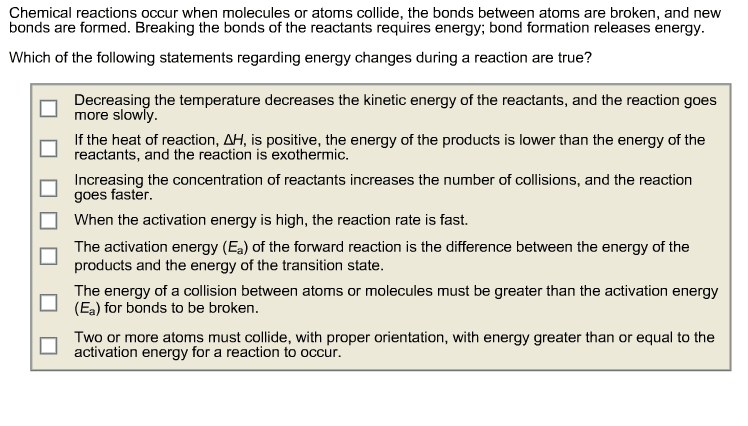CHEM10006 Study Guide - Final Guide: Exothermic Reaction, Endothermic Process, Rate Equation

Activation energy (E
a
): The threshold energy which must be overcome for a reaction to occur,
for a forward reaction it the difference between reactants & transition state, and for a reverse
reaction it is the difference between products & the transition state
Transition state: A high energy conformation of system that must be achieved before a reaction
can occur; higher barrier leads to a slow reaction
Arrhenius equation: Tells how temperature
and activation energy affect fraction of
collisions with enough energy to occur: A =
frequency factor (includes frequency of
collisions & their orientation)
If K is measured at two temperatures, E
a
can be determined
Reaction mechanisms
Net overall reaction is the result of a series of simple, elementary reactions , together the series
creates the reaction mechanism
The overall rate law derived from the mechanism must agree with the observed rate law for the
overall reaction
Rate determining step: slow step, directly related to rate law for the overall reaction
Concentration table: ICE method
Le Chatelier’s principle: If an outside influence upsets an equilibrium, the system undergoes a
change in direction that counteracts the disturbing influence, &, if possible, returns the system
to equilibrium
➔Adding reactant: adjusts to consume reactants
➔Adding product: adjusts to consume products (reverse reaction favoured)
➔Exothermic reaction: temperature increase will reduce K (A + B > C + D + heat)
➔Endothermic reaction: temperature increase will increase value of K
➔Gaseous reactions: decreasing volume of container will push equilibrium in direction
of fewer gaseous molecules (less moles) to reduce pressure
1. Only equilibrium concentrations can be substituted into the equilibrium constant
expression
2. Initial concentration should be in mol L
-1
& represent concentration when prepared
3. Changes in concentration always occur in the same ratio as the coefficients in the
balanced equation
4. Change row: concentrations of reactants should all change in the same direction &
have the same sign. Row product concentrations should all change in the opposite
direction & have the opposite sign
Often requires solving quadratic equations
Remember to only accept positive values for concentrations
Check using Q
c
Can sometimes assume change (+x) to be 0 if insignificant
Reversible reactions:

